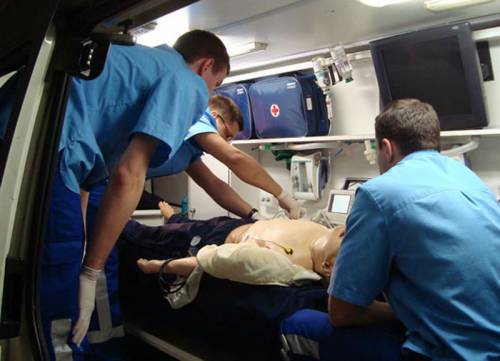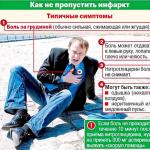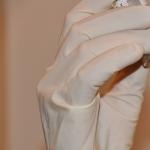Myocardial infarction is one of the severe forms of acute coronary heart disease. Mortality statistics puts the disease in one of the first places (along with a stroke) among various cardiac pathologies. The disease always develops suddenly, and given the provoking factors, it can catch a person anywhere.
Emergency care for myocardial infarction should be provided as soon as possible and in full. The further prognosis of the patient's life depends on its quality.
What are the symptoms of acute myocardial infarction?
Signs of acute coronary pathology are typical and striking. Most often, the patient appears:
- sudden burning pain behind the sternum with irradiation to the left (in the collarbone, shoulder blade, jaw, arm);
- possible feeling of squeezing the chest;
- interruptions in the rhythm of the heart;
- dizziness;
- increasing weakness, pallor of the skin.
Asphyxiation as a consequence of acute heart failure is less common at the same time.
Even less frequently, a heart attack is masked by abdominal pain, neurological symptoms (paresis, paralysis).
Pain can be "seen" by the gestures and behavior of a person
Any person needs to learn how to help, because a similar misfortune can happen to your loved ones.
What can an ordinary passer-by do?
If you have met with similar manifestations, then the best thing to do is to quickly call an ambulance. On the phone, you need to describe in detail the symptoms found in a stranger. Try to maintain psychological contact with the patient, to calm him down. Keep in mind that even if he closes his eyes, consciousness is completely preserved. You can ask questions, find out the phone number of relatives and contact them.
- create peace for the patient (stop noise, hustle);
- unbutton a tight collar, belt;
- arrange the ward in a horizontal position, raising his head with a pillow or any bundle;
- ask the victim about previous attacks, perhaps he knows his illness and carries medicine in his pocket;
- give the patient a Nitroglycerin tablet under the tongue (if available, use Isoket spray 1-2 presses of the cap);
- at home, put a mustard plaster on the area of \u200b\u200bthe heart and give 2 tablets of Aspirin to drink;
- require the patient to take deep breaths.
If you do not see any result from your actions, the person turns blue, loses consciousness, stops breathing, it is necessary to proceed to resuscitation measures (indirect heart massage and artificial respiration).
First aid for myocardial infarction requires a minimum of skills, decency and compassion for the patient from a person unfamiliar with medicine.
What ambulance doctors do
The ambulance doctor is obliged to examine the patient, conduct an initial diagnosis and provide first aid. Therapy provides for the beginning of the fight against possible complications,. Patient care standards include:
- ensuring physical and mental peace, the patient from the street is placed in the car;
- repeated intake of nitropreparations under the tongue;
- oxygen supply through a mask;
- anesthesia with injections of Analgin, narcotic analgesics, Fentanyl with Droperidol;
- the introduction of antihypertensive drugs for high blood pressure;
- removal of an ECG and determination of the size of the infarct zone and the correctness of the rhythm.
In order to restore the patency of the coronary vessel that caused the infarction, thrombolysis is performed. According to the algorithm of actions, it is necessary to inject a solution of Streptokinase for transmural infarction in the first six hours. With a repeated heart attack, a time interval of 12 hours is allowed. Enter through a dropper intravenously 1.5 million IU.
If the infarction zone is located under the endocardium, then 5 thousand units of Heparin are injected by jet.

Inside the ambulance, everything is adapted for diagnostics and prepared for urgent measures
What complications should be expected in the first hours?
Any emergency assistance is effective if provided at the optimal time. This is sought by the health authorities to reduce deaths from myocardial infarction.
It is impossible to predict in advance how the disease will develop, so doctors expect different options for a complicated course.
- Rhythm disturbances in the form of extrasystole, atrial fibrillation. The most dangerous is ventricular fibrillation. This condition requires defibrillation.
- A drop in blood pressure indicates a state of shock. Steroid hormones are administered intravenously, a system with Reopoliglyukin is placed.
- Allergic reactions to Streptokinase are possible. Hormonal agents are introduced.
- The development of acute heart failure by the type of cardiac asthma and pulmonary edema. "Defoamers" are added to the therapy, oxygen is passed through alcohol.
With myocardial rupture with tamponade of the heart bag, it is almost impossible to have time to provide surgical care.
The patient should be taken to the hospital as soon as possible and transferred to the hands of resuscitators. Information about all previously administered drugs is transferred to the emergency department and recorded in the medical history. This is important for determining the dosage and time of re-introduction of anticoagulants, analgesics.
The unfavorable situation in terms of mortality from diseases of the heart and blood vessels is confirmed by the increase in the proportion of men who died at working age from 53 to 61%, and women from 61 to 70%. Most of them are due to acute myocardial infarction and its complications.
Undoubtedly, government measures play a decisive role. But let's help strangers who are in a difficult situation. Do not walk past a falling or choking person. You may also need help.


